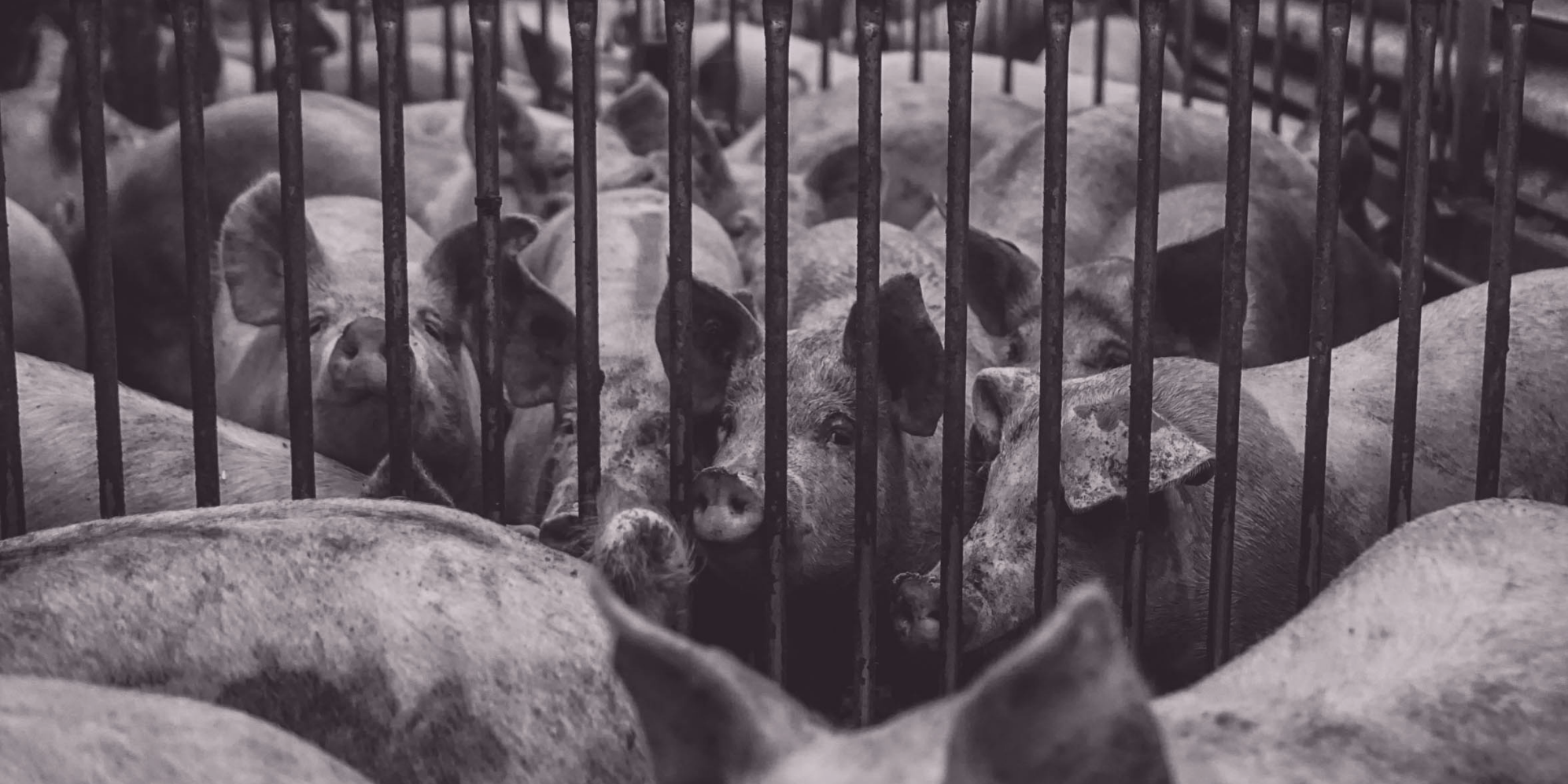
BTS and RAUS: The Two Animal Welfare Programmes
BTS and RAUS are animal welfare programmes that oblige participating farmers to meet higher requirements for animal farming than the minimum standards. The Swiss government subsidizes farms that join the allegedly animal friendly BTS (Besonders tierfreundliche Stallhaltungssysteme / particularly animal-friendly housing systems) and/or RAUS (regelmässiger Auslauf im Freien / regular outdoor exercise) programmes. Neither BTS nor RAUS are obligatory. Each farmer is free to decide whether, with which type of livestock and in which of both programmes he wishes to participate.1 A farmer can have a RAUS–certified dairy farm, while he does not participate in any of the two programs with chickens and pigs. As already mentioned, BTS and RAUS are praised to be especially “animal–friendly”. Not only the Swiss state boasts about the active participation in the two programmes. The brand “Schweizer Fleisch” (Swiss Meat), for example, launched an advertising campaign consisting of TV commercials and billboards that focused on the brand’s membership in the two programs. Swiss Meat is featured as follows on its website:
Schweizer Fleisch [Swiss Meat] deserves full trust because the standard of livestock husbandry is very high. After all, the family farms have a close relationship to the animals. In addition, the state promotes responsible husbandry – e.g. with the programmes “Particularly animal-friendly housing systems” (BTS) or “Regular outdoor exercise” (RAUS). More than three quarters (75.3%) of farm animals participate in the “RAUS” programme, more than half (55.6%) in the “BTS” programme (2015). (Translated from German)2
The following article will clarify the advantages of BTS and RAUS over conventional animal farming and will comment whether the media presentation of the programmes corresponds to reality.
particularly animal-friendly housing systems: the BTS regulations
The aim of the BTS programme is to design stable areas in such a way that it meets the animal’s welfare requirements as closely as possible. In contrast to purely conventional farms, BTS-certified ones are structured by a multi-surface housing system, which means that the barn is divided into different functional areas, namely resting, walking and feeding areas. These areas are intended to enable the animals to move more naturally and to switch between rest, movement, activity and eating in a self-determined manner. In addition, it is mandatory that the sleeping areas must be equipped with straw mattresses or soft mats.3 As far as the minimum requirements of the size of the sleeping and exercise areas are concerned, the same standard applies as for purely conventional farms. So although the animals have better room division and more comfortable resting areas at their disposal, they neither enjoy the freedom to exercise nor the option of a larger movement area. For comparison:
| Pig 110kg | Conventional Farming | BTS |
|---|---|---|
| Total area: | 0.9m² | 0.9m² |
| Sleeping area: | 0.6m² | 0.6m² |
| Outdoor area: | none | none |
Is the particularly animal-friendly housing particularly animal-friendly?
A survey carried out by the animal rights organization Tier-im-Fokus shows that most people have a distorted view about what BTS consists of and under what conditions the animals have to live. 88 percent of the interviewed persons believed that BTS involves grazing or outdoor exercise and 70 percent estimated that no more than five chickens may be kept on one square meter; both ideas do not correspond to reality. As has just been shown, BTS does not prescribe free access to an outdoor area and not five but 13 to 17 chickens can be held on a square meter in BTS farms.4 The age at slaughter is the same under BTS as with conventional farmed animals (e.g. thirty days for chickens) and the programme does not contribute to reducing the genetic physical damage caused by overbreeding.
In addition, undercover footage provided by the Swiss animal rights organization Pour l’Égalité Animale shows the conditions in a poultry farm from “Optigal” (Migros). Optigal products originate from BTS farms. The video shows thousands of chickens pressed against each other, some having open wounds and some being already dead.
Migros commented on the footage by explaining that nothing that can be seen in the recordings did violate either the Swiss Animal Welfare Act nor the BTS provisions.5 Swiss Television (SRF) has also published a critical article on chicken farming under BTS standards. The report presents undercover investigations to which operators of BTS facilities comment. Roland Pfister, spokesman for Micarna, one of the biggest Swiss meat processing companies, commented on the reporter’s question as to whether a mortality rate of 4 percent for broiler chickens in a BTS barn could be described as particularly animal-friendly that this mortality rate is simply normal and that “animal welfare executed under BTS is as high as possible in today’s system”. According to Pfister, the fact that animals nevertheless have to be kept crowded together in confined spaces is necessary in order to produce a “high-quality product for a good price”6
Own research done by The Animalist coincides with the results of PEA. BTS poultry farms managed by meat processor Bell contain injured animals, overcrowded stables and polluted areas. Bell actively contributes to the misleading marketing of poultry with advertising slogans such as “typically Swiss” followed by a picture of a chicken wearing traditional Swiss dress. The reality looks quite different.
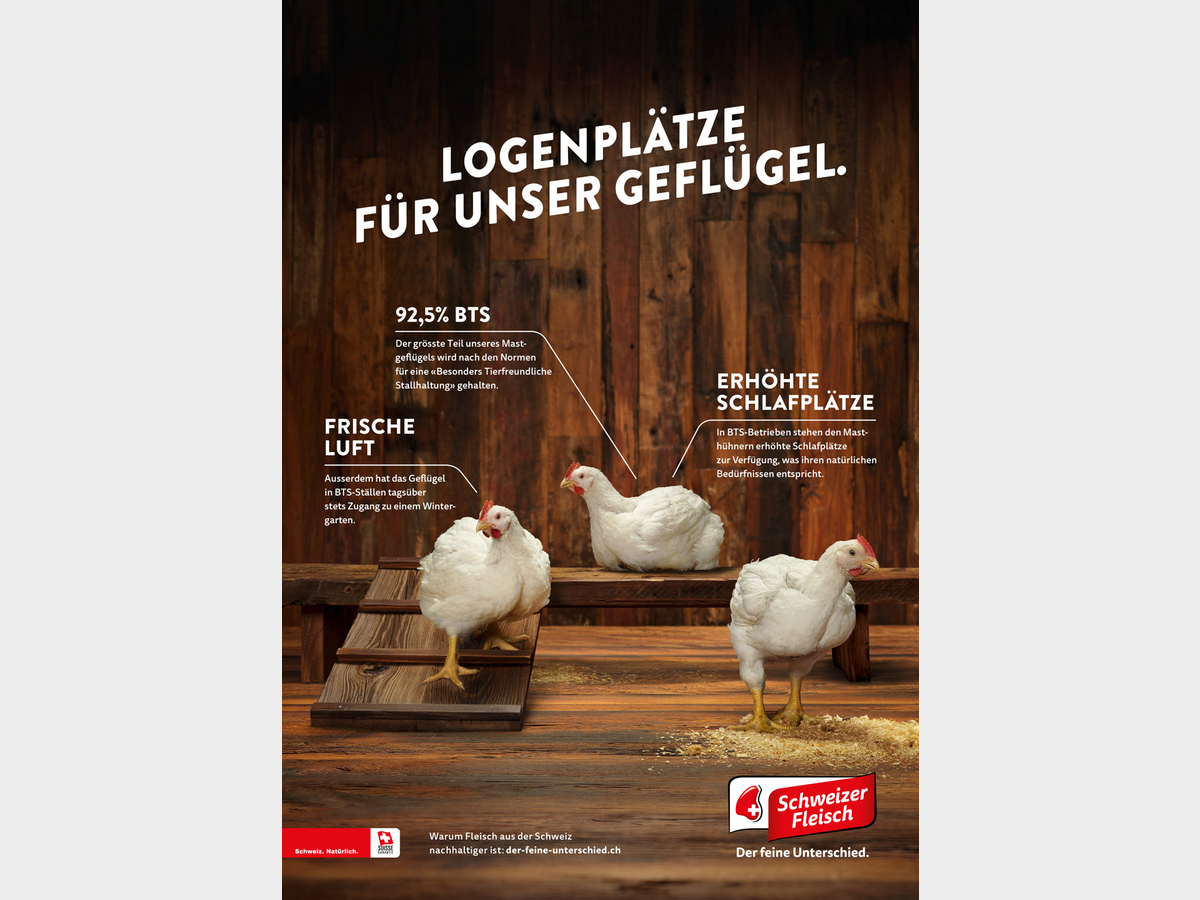 Advertisement made by Schweizer Fleisch highlighting their participation in the BTS programme.2
Advertisement made by Schweizer Fleisch highlighting their participation in the BTS programme.2
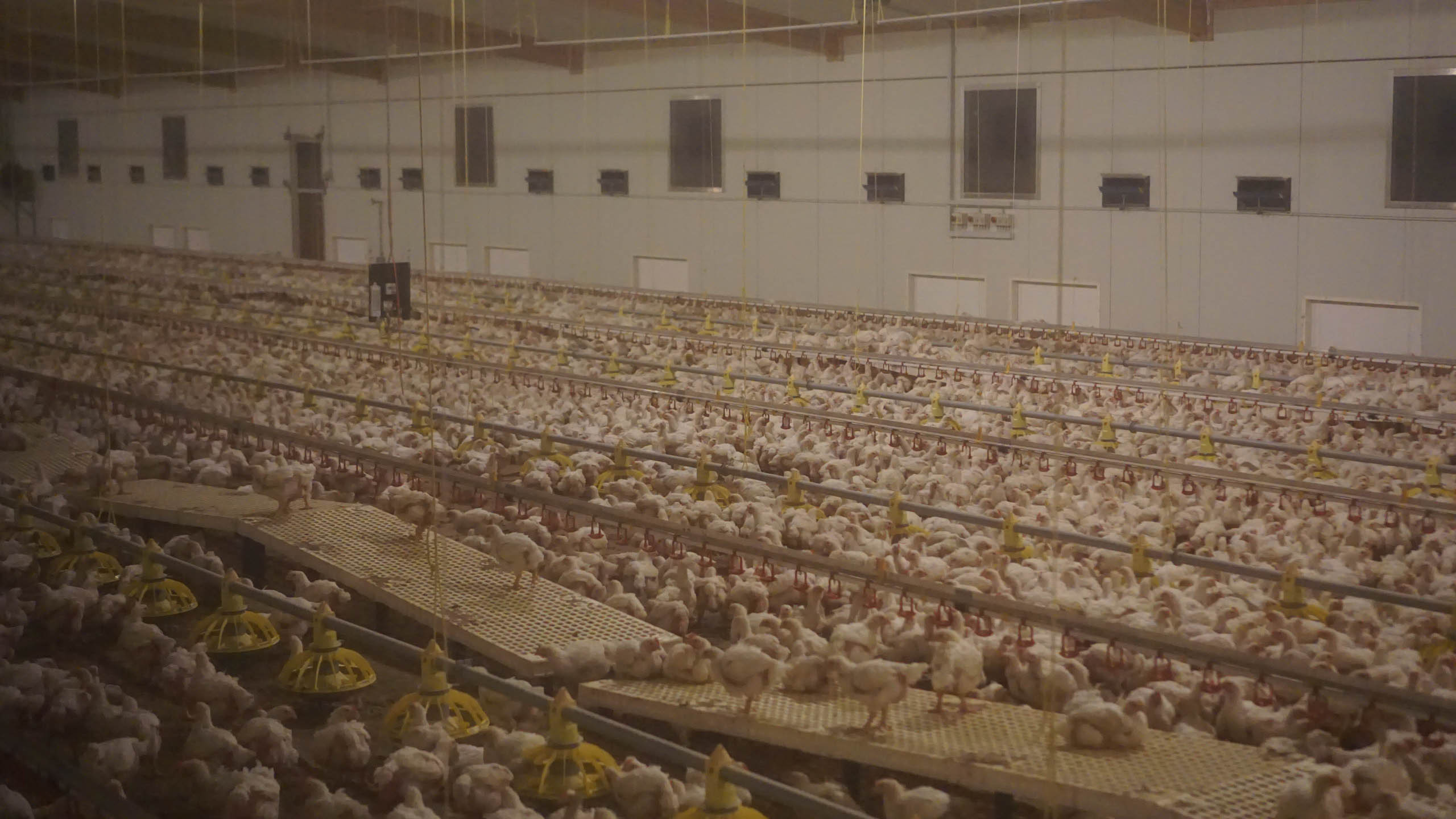 A BTS-certified farm in Bern. Up to 24,000 chickens are permitted in BTS farms. The chickens live in confined spaces and have no retreat. The picture shows the elevated sleeping areas; they consist only of an elevated flat surface on which not even a third of the chickens can sit. Many chickens die prematurely because they are crushed, trapped somewhere or can no longer stand up. The chickens only have access to the outside area after they are three weeks old. When they are about 36 days old, they get killed.
A BTS-certified farm in Bern. Up to 24,000 chickens are permitted in BTS farms. The chickens live in confined spaces and have no retreat. The picture shows the elevated sleeping areas; they consist only of an elevated flat surface on which not even a third of the chickens can sit. Many chickens die prematurely because they are crushed, trapped somewhere or can no longer stand up. The chickens only have access to the outside area after they are three weeks old. When they are about 36 days old, they get killed.
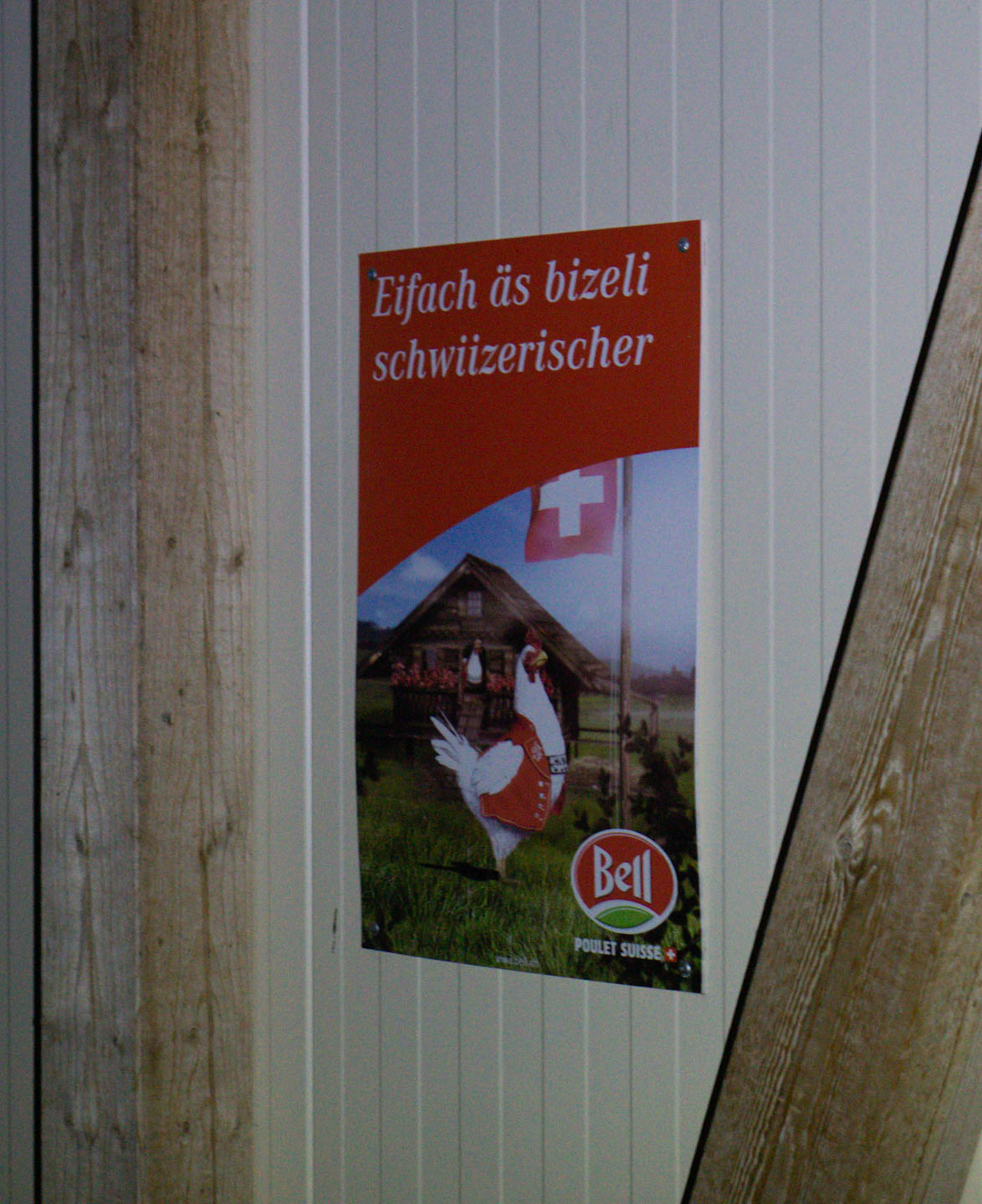 Bell appeals to Swiss values. The chicken in the picture wears traditional Swiss clothes and is standing in the middle of a large meadow.
Bell appeals to Swiss values. The chicken in the picture wears traditional Swiss clothes and is standing in the middle of a large meadow.
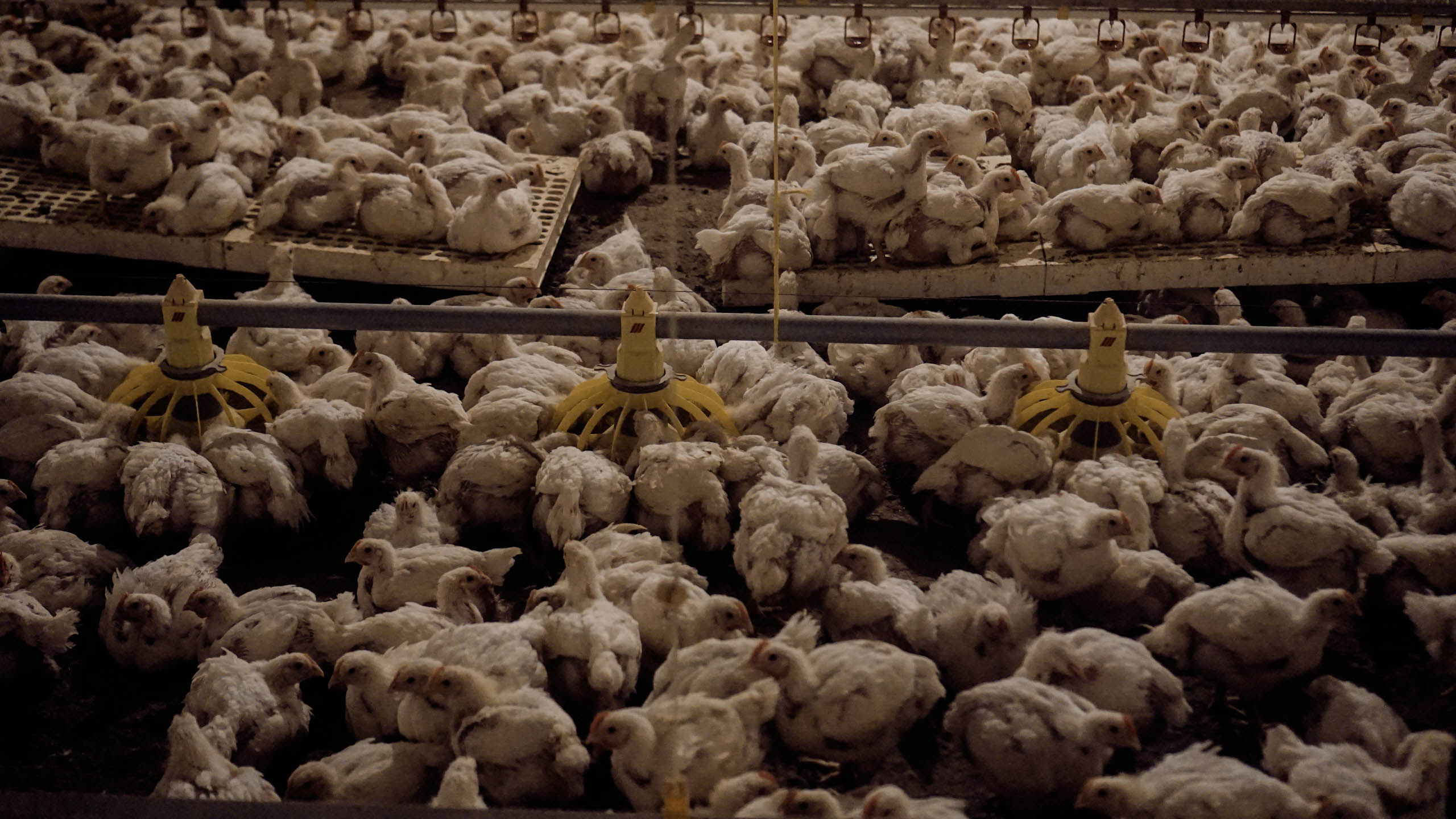 “Eifach äs bizeli schwiizerischer”. The picture shows the inside of the farm where the Bell poster is displayed. Intensive livestock farming is no exception in Switzerland any more. Swiss broiler chickens do not live on green meadows, but in huge halls.
“Eifach äs bizeli schwiizerischer”. The picture shows the inside of the farm where the Bell poster is displayed. Intensive livestock farming is no exception in Switzerland any more. Swiss broiler chickens do not live on green meadows, but in huge halls.
Although BTS brings an improvement compared to purely conventional animal farming, it is questionable whether Migros, Bell or Schweizer Fleisch can use BTS to convince consumers that the animals they eat are held in particularly animal-friendly facilities. The advertising is clearly misleading and does not correspond to the real conditions.
BTS in a nutshell:
| + | multi-surface animal husbandry system |
| + | resting areas are equipped with straw or soft mats |
| - | no outdoor time |
| - | no limit regarding the maximum number of animals |
| - | no raise in slaughter age |
| - | no enhanced regulations on genetic manipulation and race-related diseases |
The RAUS-Regulations
DThe second of the animal welfare programmes is called the RAUS. It stipulates the obligatory condition that animals must either be taken out to graze for a certain number of days or to be allowed to enter a yard or an outdoor area.7 From May to the end of October, the cows and cattle must spend at least 26 days and from November to the end of April at least 13 days per month on a pasture. If no access to grazing can be guaranteed, the RAUS regulations can still be met if the animals have access to an outside area throughout the year (this is often used with dairy cows).8 Unlike BTS, RAUS is fully suitable with the practice of tying cows to a specific place in the barn during some time of the year. This type of housing systems is mostly used for dairy cows and often gets combined with RAUS, as the cows spend most of the summer grazing and are fixed during winter period. According to the newspaper “Schweizer Bauer”, about 50 percent of the existing cowsheds in Switzerland still use the method of fixation.9 These types of stables have currently been criticised by the Federal Administration10 as well as by other agricultural associations, as the severe physical restriction of the animals can lead to postural damage, infections due to the animal not being able to clean themself, wounds from lack of movement and psychological disorders caused by the lack of social contact.11
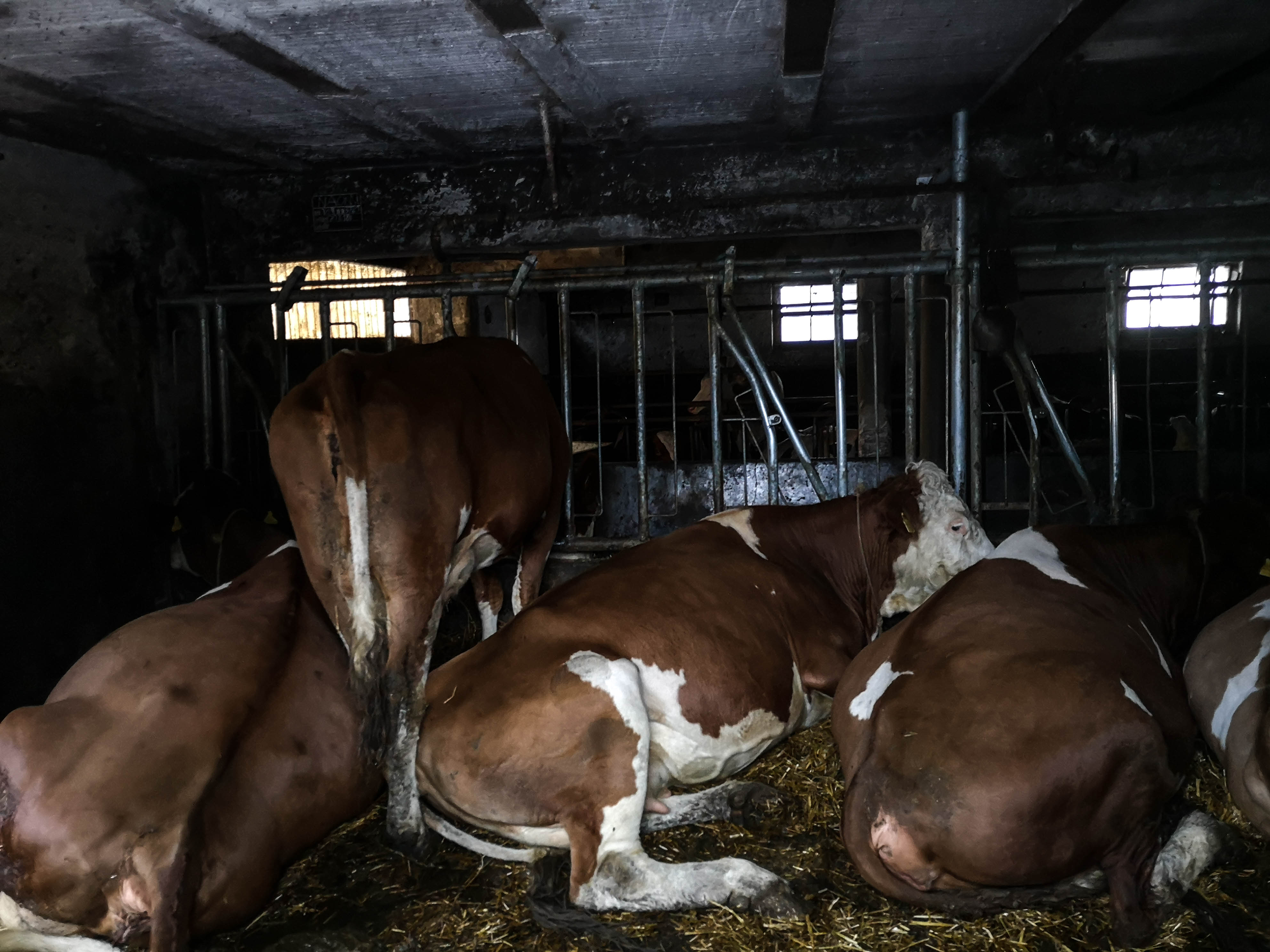 The cows are fixed around the neck and on the tail. They can neither clean themselves nor interact properly with their comrades. The picture was taken in Kandersteg BE.
The cows are fixed around the neck and on the tail. They can neither clean themselves nor interact properly with their comrades. The picture was taken in Kandersteg BE.
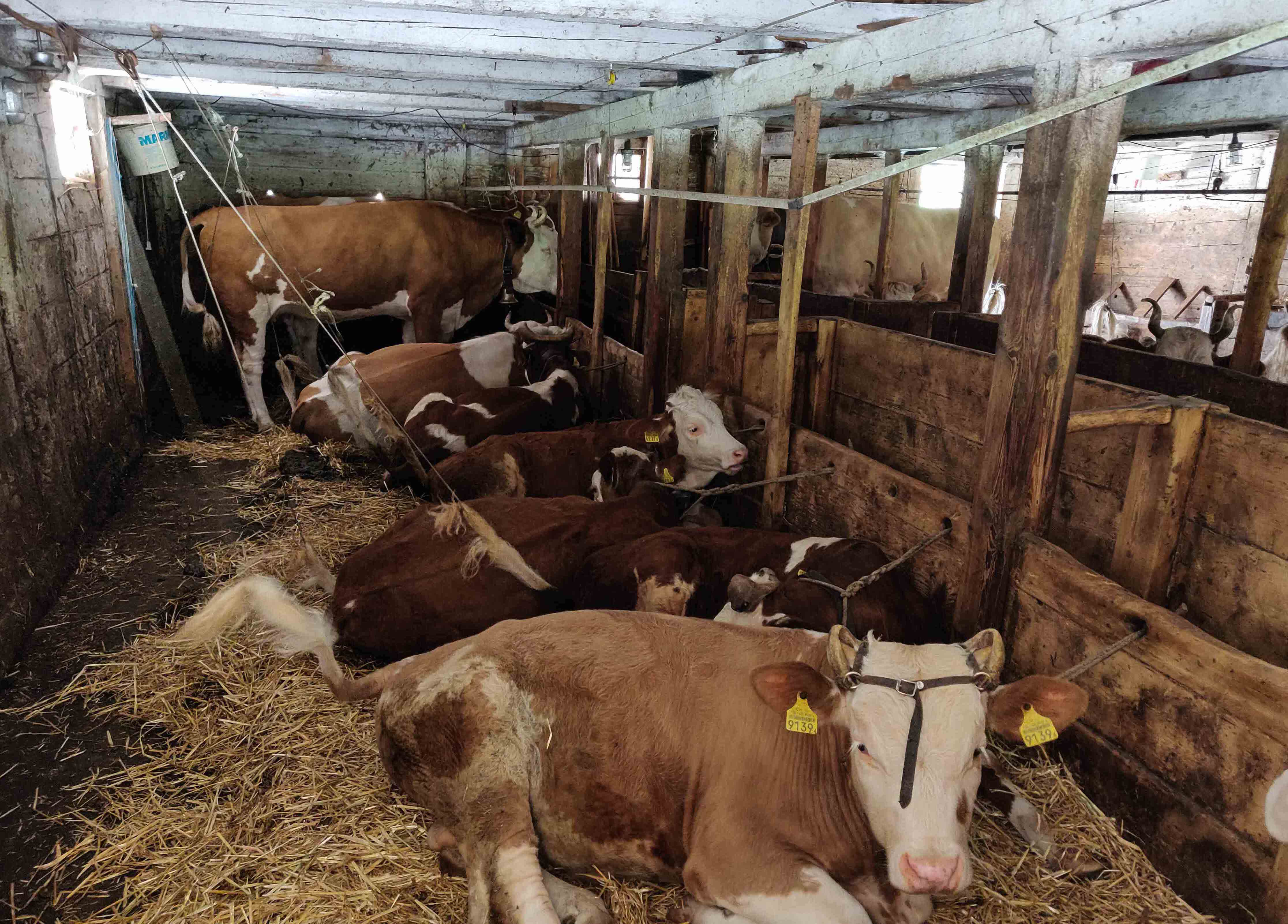 The cows have trouble resting at the same time. Due to their fixation, they are forced to sleep in their own excrements. The picture was taken in Bern.
The cows have trouble resting at the same time. Due to their fixation, they are forced to sleep in their own excrements. The picture was taken in Bern.
Being allowed to go outside does not mean the same for all species
RAUS cannot be equated with obligatory grazing time. According to the Ethoprogrammverordnung the RAUS-requirements are fulfilled if the animals are allowed to stay on pasture or in an outdoor climate area. Grazing is usually applied to some dairy cows or cattle – while pigs and chickens are almost always held in outdoor yards. These outside areas are less generous. For cocks and hens an outdoor climate area must cover 43 m² per 1000 animals.12 Pigs weighing 110kg must be allowed to exercise for several hours a day13 n an area of 0.65m² per pig.14 For comparison:
| Pig 110kg | Conventional Farming | RAUS |
|---|---|---|
| Total area: | 0.9m² | 1.55m² |
| Sleeping area: | 0.6m² | 0.6m² |
| Outdoor area: | none | 0.65m² |
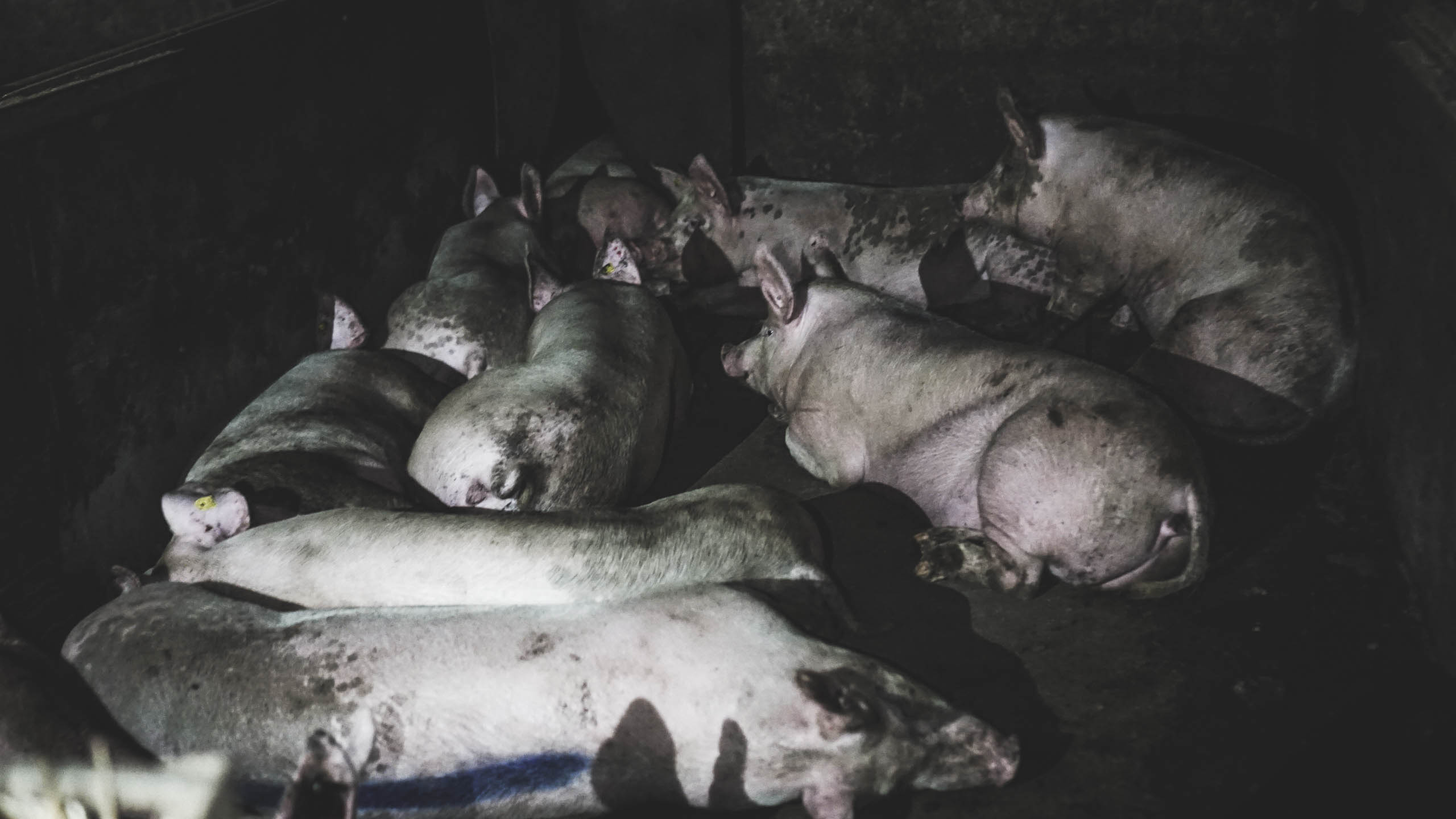 Inside a RAUS-certified piggery. Almost without exception, pigs are kept in confining conditions, where they have no possibility to entertain themselves or to move freely. Since this piggery is only RAUS-certified, the pigs do neither get straw nor a soft base to sleep on.
Inside a RAUS-certified piggery. Almost without exception, pigs are kept in confining conditions, where they have no possibility to entertain themselves or to move freely. Since this piggery is only RAUS-certified, the pigs do neither get straw nor a soft base to sleep on.
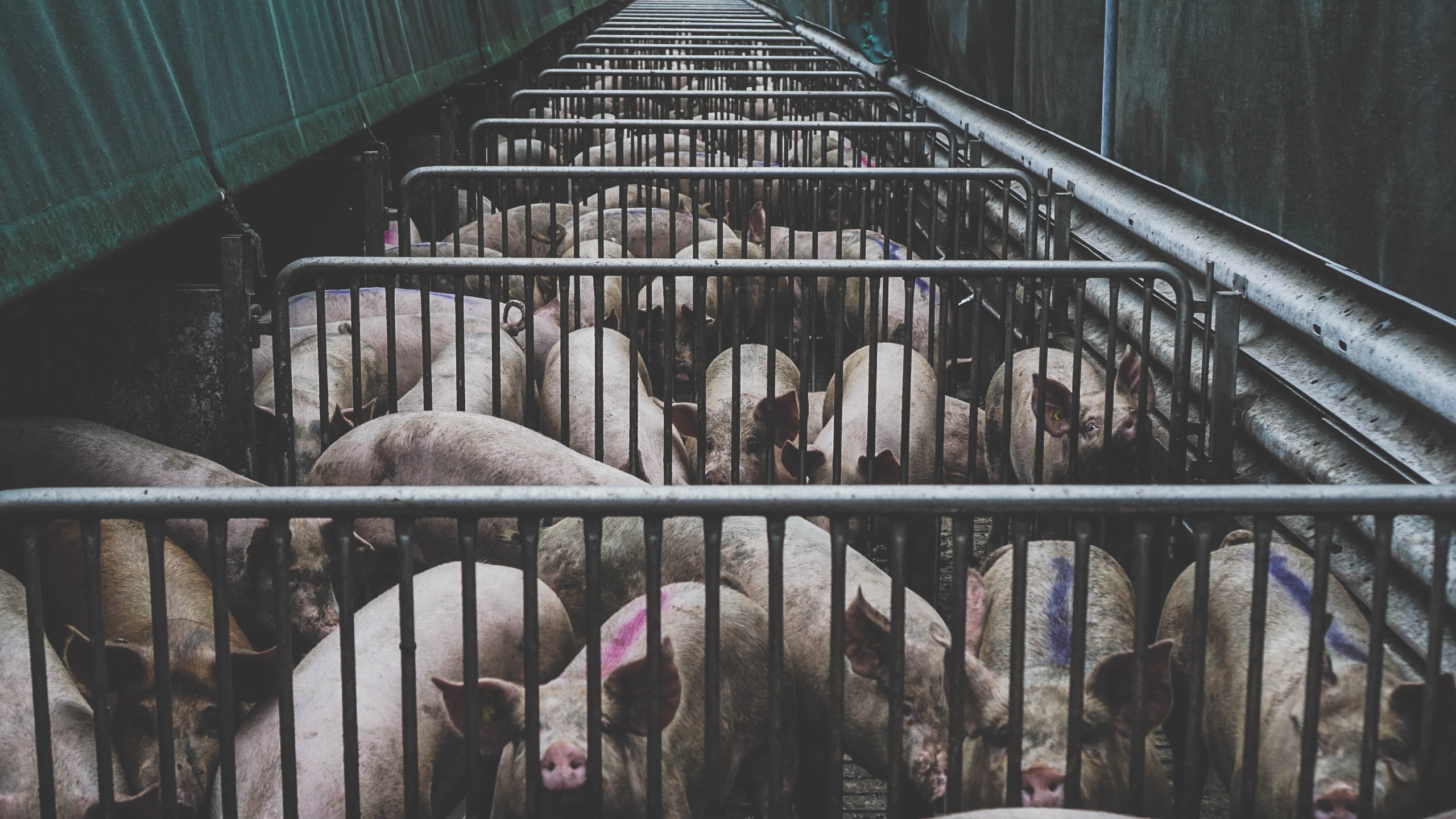 The outdoor area of a piggery. Although the pigs can go outside, they still have little space and no entertainment opportunities. Like most animals, pigs are clever animals that have a strong urge to discover and to be active. They are completely denied the opportunity to live out these natural instincts.
The outdoor area of a piggery. Although the pigs can go outside, they still have little space and no entertainment opportunities. Like most animals, pigs are clever animals that have a strong urge to discover and to be active. They are completely denied the opportunity to live out these natural instincts.
RAUS in a nuthsell:
| + | Obligation to offer the animals access to an outdoor area |
| - | Compatible with the fixation of cows |
| - | Different implementation of RAUS for different types of animals |
| - | No limitation of the number of animals held in a farm |
| - | no raise in the slaughter age |
| - | no enhanced regulations on genetic manipulation and race-related diseases |
It may be that Switzerland performs better than the EU in terms of minimum animal welfare conditions as well as in terms of the general participation in voluntary animal welfare programmes such as BTS and RAUS. However, it is not automatically guaranteed that the minimum requirements or even advanced animal welfare requirements are animal-friendly. An animal welfare law can be totally miserable for the animal, although it is the most progressive in the world. In addition, misinformation regarding BTS and RAUS and extensive marketing efforts by meat and dairy unions also lead to consumers being mistaken about the current conditions on BTS and RAUS farms, which in turn reproduces the distorted self-portrait of Switzerland as an “animal-friendly” place.
Footnotes
-
Tierwohlbeiträge BTS/ RAUS, Bundesamt für Landwirtschaft https://www.blw.admin.ch/blw/de/home/instrumente/direktzahlungen/produktionssystembeitraege/tierwohlbeitraege.html ↩
-
Schweizer Fleisch, https://www.schweizerfleisch.ch/wieso-schweizer-fleisch/qualitaet-und-sicherheit/tierhaltung.html Schweizer Fleisch has since removed this qupte, however, here they mention their participation in BTS and RAUS now here: https://schweizerfleisch.ch/herkunft/pluspunkte-fuer-schweizer-fleisch ↩ ↩2
-
Verordnung über die Direktzahlungen an die Landwirtschaft, Artikel 74 ↩
-
tier-im-fokus, Studie zeigt: der Bund täuscht die Bevölkerung, 24.03.2018, https://www.tier-im-fokus.ch/medienmitteilungen/bts-umfrage_2018 ↩
-
Tscherring, Tobias, So himmeltraurig geht es den Hühnern der Migros-Marke «Optigal», 16.07.2018, https://www.infosperber.ch/Gesundheit/Verdeckte-Aufnahmen-zeigen-tote-Huhner-im-Migros-Stall ↩
-
FOKUS: Der Tod ist Teil des Geschäfts, 30.01.2018 https://www.srf.ch/play/tv/10vor10/video/fokus-der-tod-ist-teil-des-geschaefts?id=9ee35e44-cc8a-4193-a3c5-5b306ce6a400 ↩
-
Verordnung über die Direktzahlungen an die Landwirtschaft, Art. 75., https://www.admin.ch/opc/de/classified-compilation/20130216/index.html ↩
-
Ethoprogrammverordung, Anhang 4 (Art. 4 Abs. 2 und 4). Fassung gemäss Ziff. II der V des WBF vom 18. Nov. 2009 (AS 2009 6293). Bereinigt gemäss Ziff. II der V des WBF vom 25. Mai 2011, in Kraft seit 1. Aug. 2011 (AS 2011 2363), https://www.admin.ch/opc/de/classified-compilation/20081115/201301010000/910.132.4.pdf ↩
-
Brunner, Martin, „So macht die Arbeit richtig Feude“, in: Schweizer Bauer, 2018, https://www.schweizerbauer.ch/tiere/milchvieh/so-macht-arbeit-richtig-freude-41156.html ↩
-
Bundesamt für Lebensmittelsicherheit und Veterinärwesen, Haltung von Rindern und Kälbern, https://www.blv.admin.ch/blv/de/home/tiere/tierschutz/nutztierhaltung/rinder/haltung-rind.html ↩
-
Tierquälerische „Anbindehaltung“ darf kein UNESCO-Weltkulturerbe werden, in: Animal Rights Watch, 21.1.2021, https://www.ariwa.org/anbindehaltung-kein-kulturerbe/, Albert Schweitzer Stiftung, Milchkühe, https://albert-schweitzer-stiftung.de/massentierhaltung/milchkuehe, Einschätzung des Tierwohlsin der Schweizer Milcherzeugung, STS-Umfrage Mai 2016, http://www.tierschutz.com/nutztiere/milchproduktion/pdf/sts_umfrage_milcherzeugung.pdf, Ökolandbau, das Informationsportal, 2019, https://www.oekolandbau.de/landwirtschaft/tier/spezielle-tierhaltung/rinder/milchviehhaltung/haltung/haltung-im-anbindestall/ ↩
-
Direktzahlungsverordnung, B Anforderungen des BTS- und des RAUS-Programms betreffend den Aussenklimabereich für Nutzgeflügel sowie betreffend die Dokumentation und die Kontrolle, 1.2 Mindestmasse, https://www.admin.ch/opc/de/classified-compilation/20081115/201301010000/910.132.4.pdf ↩
-
Direktzahlungsverordnung, D, 2. Tiere der Schweinegattung, https://www.admin.ch/opc/de/classified-compilation/20081115/201301010000/910.132.4.pdf ↩
-
Direktzahlungsverordnung, E Anforderungen des RAUS-Programms betreffend den Laufhof und die Weide sowie betreffend die Dokumentation und die Kontrolle, 6 Laufhof für die Tiere der Schweinegattung, a. Mindestflächen, https://www.admin.ch/opc/de/classified-compilation/20081115/201301010000/910.132.4.pdf ↩